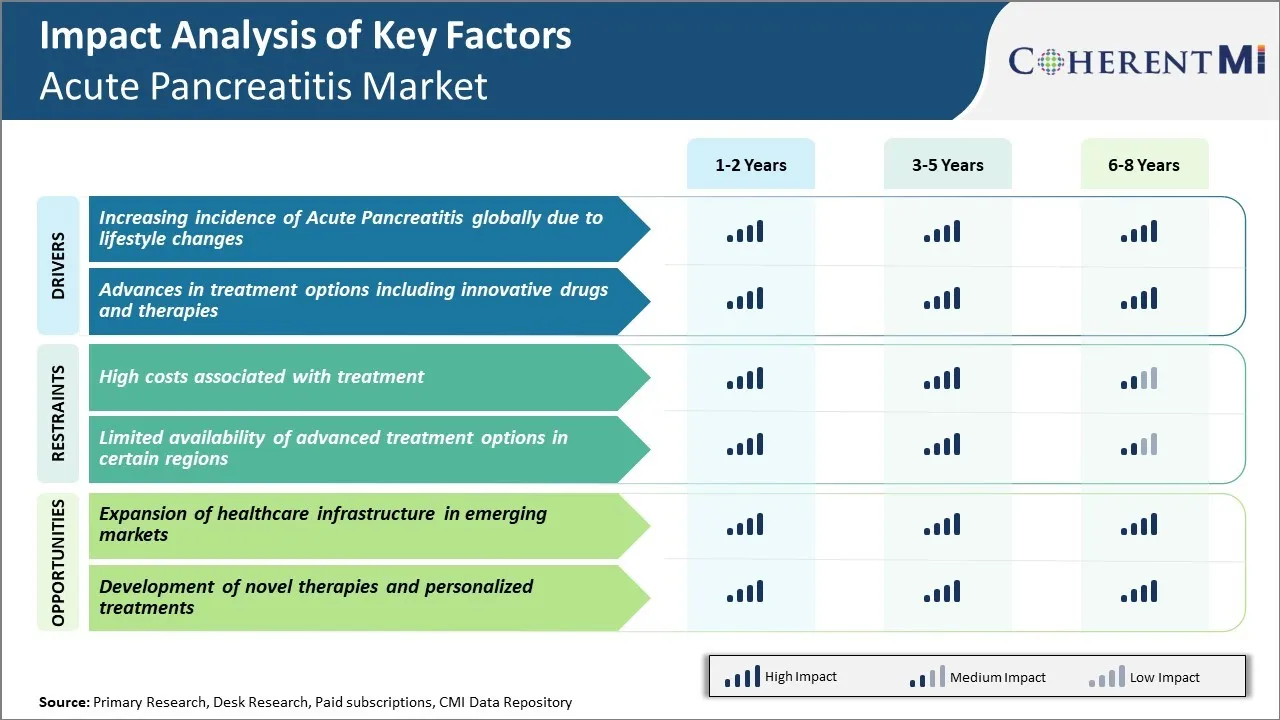Acute Pancreatitis Market Trends
Market Driver - Lifestyle Changes Fueling Rise in Acute Pancreatitis Cases
The global incidence of acute pancreatitis has been rising steadily over the past few decades. A key factor behind this rise has been the widespread lifestyle changes that more and more people are adopting. Unhealthy eating habits, physical inactivity, excessive alcohol consumption and smoking are some of the major lifestyle aspects that are considered significant risk factors for developing acute pancreatitis.
Excessive alcohol intake has likewise become very common, especially among younger demographic groups. Binge drinking is almost seen as casual socializing by many. But medical research has clearly shown that heavy sporadic or regular alcohol consumption can easily trigger acute pancreatitis attacks. Similarly, the number of smokers worldwide also continues to be alarmingly high despite anti-tobacco campaigns. Cigarette smoking is a well-established risk factor that has been implicated in many cases of acute pancreatitis.
All of the above lifestyle habits that promote weight gain, metabolic disorders and put additional strain on digestive organs have led to a surge in the occurrence of acute pancreatitis. Unless concerted efforts are made to promote healthier lifestyle changes on a mass scale, instances of acute pancreatitis stemming from an inappropriate modern lifestyle will keep growing over the coming years.
Market Driver - Advances in Treatment Options for Acute Pancreatitis
One of the key areas where substantial advancements have occurred is in drug development for treating the underlying causes and modulating the disease process. Several clinical trials over the past decade have evaluated different medications that can help reduce pancreatic inflammation and accelerate recovery. A few promising drug classes under investigation include enzyme inhibitors, anti-oxidants, anti-inflammatory agents and certain immunomodulators. If proven safe and effective, these newer drug formulations will enhance clinicians' armamentarium to deal with acute pancreatitis cases.
At the same time, minimally invasive surgical techniques and interventional endoscopic options are also gaining ground. Procedures like endoscopic retrograde cholangiopancreatography (ERCP) enable diagnosing and addressing conditions like gallstones which frequently underlie pancreatitis attacks. Similarly, procedures to place drainage stents in problematic pancreatic ducts are boosting management of complications. The integration of advanced imaging methods and image-guided precision has further augmented such interventional approaches.
Overall, continual refinements in the therapy paradigms backed by a stream of innovative medications and technologies bode well for improving patient outcomes and quality of life in acute pancreatitis. This progress is anticipated to strengthen the commercial outlook of this industry as it fosters higher demand for better-tolerated and more effective therapeutics over the conventional standard of care.

Market Challenge - High Costs Associated with Treatment
One of the major challenges faced by the acute pancreatitis market is the high costs associated with treatment. Acute pancreatitis requires hospitalization and intensive medical care. The treatment involves extensive monitoring along with administration of intravenous fluids and pain medications. In severe cases, surgical intervention may also be required which further increases the overall costs.
Due to the complex nature of the disease, the treatment costs per patient are considerably high. As per estimates, the average total costs per patient range between $15,000 to $30,000 in the United States depending on the severity level. This places a huge financial burden on patients and their families. Moreover, the in-patient hospital stays associated with acute pancreatitis are substantially long which puts additional cost pressures on the already over-burdened healthcare systems across regions.
With rising incidence rates of acute pancreatitis, the spending on treatment is projected to grow significantly. However, the limitations in healthcare budgets and reimbursement challenges pose constraints in addressing the rising disease burden. This acts as a major market challenge that needs to be tackled for ensuring accessible and affordable care.
Market Opportunity - Expansion of Healthcare Infrastructure in Emerging Markets
One of the key opportunities for the acute pancreatitis market is the expansion of healthcare infrastructure in emerging markets. There is growing investments towards building healthcare facilities and improving access to advanced treatment options in developing countries.
This includes setting up of new hospitals, expansion of medical infrastructure in rural areas, and increasing healthcare spending per person by various governments. As a result of these developments, more patients are now able to seek timely treatment for acute pancreatitis even in remote locations.
Additionally, improved diagnostic capabilities are enabling early detection and management of the disease. This factor is positively impacting the market growth in emerging nations. With further planned investments towards strengthening healthcare systems, emerging markets are expected to provide significant expansion prospects for players in the acute pancreatitis market over the coming years. Companies can gain a competitive edge by focusing on these high potential regions and catering to the rising medical needs.